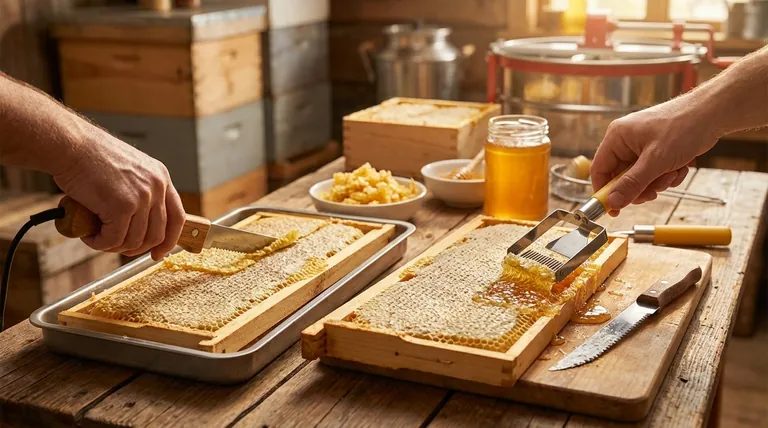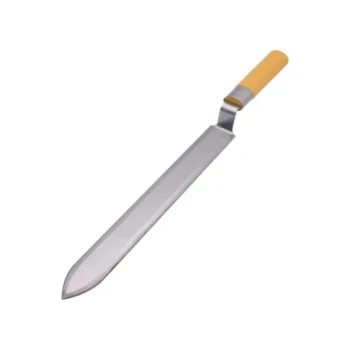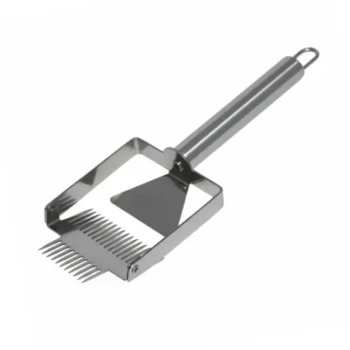To uncap honey frames, beekeepers use one of two primary methods: slicing the wax cappings off with a knife or pulling them off with a fork-like tool. The most common tools are electric heated knives, simple cold serrated knives, and uncapping forks or scratchers. While a heated knife offers speed, many find an uncapping fork is easier to use and gentler on the comb structure.
Your choice of an uncapping tool is a decision between speed and comb preservation. While knives can be faster for large batches, an uncapping fork is often the most forgiving, economical, and bee-friendly option, especially for new beekeepers.

The Two Primary Methods: Slicing vs. Pulling
Before selecting a specific tool, it's essential to understand the two fundamental approaches to removing the wax cappings that seal the honey in the comb.
Using an Uncapping Knife (Slicing)
This method involves using a long blade to slice off the entire layer of wax cappings in one or two passes. It is often the faster method for perfectly flat, full frames of honey.
Using an Uncapping Fork or Scratcher (Pulling)
This technique uses a tool with sharp tines to lift or pull the cappings off the cells. This approach follows the unique contours of each frame and is often praised for minimizing damage to the underlying comb.
A Closer Look at Your Tool Options
Each method has several associated tools, ranging from simple and manual to powered and highly efficient.
The Electric Heated Knife
This is the most convenient tool for processing a large number of frames. An internal heating element melts the wax as you slice, allowing the knife to glide through the cappings with minimal effort.
The Cold (Serrated) Knife
This is the traditional, non-electric option. It is essentially a long, sharp, serrated knife, similar to a bread knife. To make slicing easier, beekeepers often dip the blade into a pot of very hot water between passes.
The Uncapping Fork (or Cappings Scratcher)
This stainless steel, pronged tool looks like a wide fork. You use it to gently pull or flick the wax cappings off the cells. It is particularly effective on uneven frames where a knife would miss low spots.
Other Tools
Less common options include pull uncappers, which shave the cappings off, and rollers, which use spikes to perforate the cappings. However, knives and forks remain the industry standard for most beekeepers.
Understanding the Trade-offs
The ideal tool depends entirely on your goals, budget, and the scale of your operation.
Speed vs. Comb Preservation
An electric knife is generally the fastest method for experienced users with many frames to process. However, the uncapping fork preserves the comb structure most effectively. This means the bees spend less time and energy repairing cells and can begin refilling them with honey almost immediately.
Cost and Complexity
Uncapping forks and cold knives are the least expensive and simplest options, requiring no power source. Electric heated knives represent a larger investment but offer significant convenience for those with more than a few hives.
The Learning Curve
The uncapping fork is widely considered the easiest tool for beginners. It is very forgiving and it's difficult to cause significant damage to the comb. Using a knife, especially a hot one, requires more practice to achieve a clean, even cut without gouging the frame or melting too much wax.
Choosing the Right Tool for Your Apiary
After uncapping, the honey must be extracted (usually via a centrifuge) and then strained through a cloth or nylon filter to remove any remaining wax particles. Your choice of uncapping tool is the critical first step in this process.
- If you are a new beekeeper with just a few hives: Start with an uncapping fork. It is inexpensive, highly effective, and the gentlest option for your bees' comb.
- If you are managing a larger operation and value speed: Invest in an electric heated knife. The efficiency gains will be significant when processing dozens of frames.
- If you are on a strict budget or prefer traditional methods: A cold, serrated knife is a perfectly viable tool. Simply keep a tall pot of hot water nearby to heat the blade.
Ultimately, the best uncapping tool is the one that aligns with your scale, budget, and beekeeping philosophy.
Summary Table:
| Tool | Best For | Key Advantage |
|---|---|---|
| Electric Heated Knife | Large Operations | Fastest for many frames |
| Cold Serrated Knife | Budget-Conscious Beekeepers | Traditional, low-cost option |
| Uncapping Fork/Scratcher | Beginners & Comb Preservation | Easiest to use, gentlest on comb |
Ready to equip your apiary with the right uncapping tools?
As a leading wholesale supplier to commercial apiaries and distributors, HONESTBEE provides the durable, high-performance equipment you need for an efficient harvest. We help you balance speed with comb preservation to maximize your honey yield and support the health of your hives.
Contact our team today to discuss your beekeeping supply needs and request a wholesale quote.
Visual Guide

Related Products
- Stainless Steel Pivoting Honey Uncapping Fork with Plastic Handle
- All-Stainless Steel Pivoting Honey Uncapping Fork for Beekeeping
- Professional Honey Uncapping Fork Tool with Customizable Tine Options
- Professional Bent Tine Honey Uncapping Fork with Ergonomic Grip
- Adjustable Stainless Steel Honey Uncapping Fork with Scraper for Beekeeping
People Also Ask
- What is the recommended practice when using plain knives for uncapping? Master the Two-Knife Method for a Perfect Harvest
- What are the advantages of an uncapping fork? Achieve Precision Honey Harvesting for Your Apiary
- Why do you uncap honey? Unlock Your Harvest with Efficient Uncapping
- What are the common methods used by small-scale beekeepers to uncap honey frames?
- What is the best way to uncap honey? Find the Perfect Tool for Your Hives



















